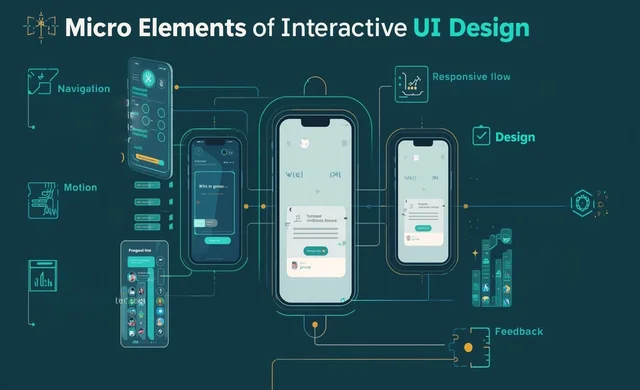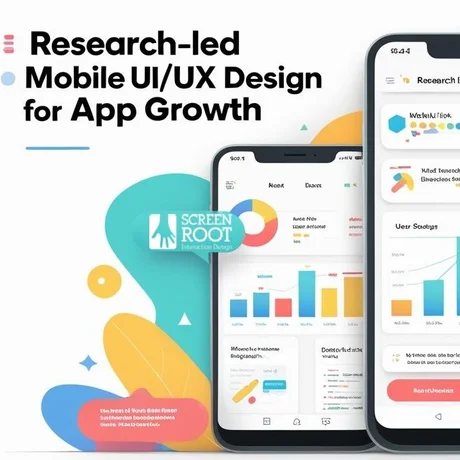Interactive UI design is at the heart of how people experience digital products today. It goes beyond simple layouts. It turns a screen into something users can touch, explore, and enjoy. When a user interacts with an app or website, every click, swipe, and scroll becomes part of a journey. This journey is shaped by thoughtful interface design.
Good UI is more than just looking visually appealing. It uses design principles that guide users through a digital interface. The goal is to keep it intuitive and usable. Navigation menus that make sense, along with interactive elements like buttons, animations, or transitions, all work together. These design elements enhance the overall user experience. In many ways, interaction design makes technology feel almost invisible. This allows users to focus on achieving their goals instead of figuring out how the system works.
Of course, this does not happen by chance. UX and UI designers rely on user research, design skills, and proven design systems to create interfaces. They ensure designs work well across websites and apps. They also make them responsive, accessible, and user-friendly. Whether it is mobile app design or enterprise platforms, the process matters. By combining creativity with usability, interactive user interfaces transform an application or website. They make it seamless and engaging.
That is why investing in professional UX design services is not just about style. It is about building a digital product that works for your users. It also drives real business value.

What Interactive UI Design Really Means?
Interactive UI design is all about building digital interfaces that feel alive and welcoming. It’s more than a layout on a screen. This design responds when a user taps, swipes, or scrolls.
Interactive UI design is simply the art of making screens that speak back. It reacts when a user does something. It adds responsiveness, animations, feedback, and intuitive flows. It makes a digital interface feel alive.
Think beyond static screens. Here, design adds motion and meaning. It gives visual feedback or subtle animation. It guides with fluid transitions or hints on where to go next.
We see interactive elements everywhere. Buttons often respond with hover states or a gentle glow. Transitions help users move from one page to another without confusion. Scroll effects may reveal new content as you slide down. Micro‑interactions, like a playful icon that dances when clicked, make things feel personal and engaging.
All these parts work together to boost user engagement. They also help keep users longer. When design feels responsive and intuitive, people stay. And that means better retention and value for businesses.

Why Businesses Need Interactive UI Today?
Digital users now demand more than static pages. They seek ease, speed, and a touch of delight in every experience. Interactive UI design brings that wow factor. It feels alive. It keeps visitors curious. That helps businesses turn visits into interactions that count. And it sets the stage for better outcomes, such as more sign-ups, deeper engagement, and happier users.
Users have little patience for clunky navigation or slow responses. They expect intuitive flows, clear feedback, and smooth design. Interactive UI design meets those expectations. It blends visual design, responsiveness, and usability. The result? A digital product that feels easy and fun. And that keeps users coming back.
This kind of dynamic interface also lifts business performance. It drives higher conversions. It cuts drop-offs. It builds loyalty and brand trust. When users enjoy their journey, they stay longer, and that means better metrics across the board.
B2B: Smarter Workflow, Stronger Tools
In the enterprise world, dashboards and complex portals can feel overwhelming. Interactive element design makes them clearer. It turns clunky workflows, such as navigating a SaaS tool, into simple steps. That enhances usability and boosts productivity.
B2C: Fun Meets Function
In consumer apps or websites, interactivity turns “just browsing” into a pleasure ride. Buttons respond with gentle animations. Navigation feels smooth. That playful feel invites users to explore, buy, or share. And that creates real user engagement.

Key Elements of Interactive UI Design
Interactive UI design is where creativity meets clarity. It layers motion, feedback, and flexibility into a digital interface in ways that actually feel natural. This section teases those building blocks. You’ll see how little moments, smooth navigation, adaptive layouts, live feedback, and motion all work together. And you’ll realize why pulling this off calls for skilled design pros, not a DIY approach.
Micro-interactions
Tiny design touches that delight. Think of a button that changes color when you tap it or a small alert that pops up after you submit something. These micro‑interactions give instant feedback and make the interface feel surface‑friendly and helpful. They humanize a digital product and can speed up understanding of how to proceed.
Navigation Flow
This is how users move through an interface. Clear navigation prevents confusion. It helps people find what they want fast. Buttons, menus, or breadcrumbs guide them. When flow works well, journeys feel smooth. That improves the overall user experience for both web and mobile app.
Responsive Layouts
Different screens, same ease. A responsive layout shifts to fit desktops, tablets, or mobile devices. It adapts size, placement, and flow. This keeps the interface friendly and usable no matter where someone interacts. It ensures consistency and helps keep the design visually appealing.
Feedback Loops
Instant signals that tell you what’s happening. Think of a progress bar filling, a confirmation message after a form, or a spinner when loading. Feedback loops reassure users. They remove doubt and keep the interaction clear. When done well, they reduce errors and build trust.
Motion and Transitions
Motion brings flow and life. A smooth slide between screens or a fade on element change speed heals the jumpiness of digital life. These transitions guide the eye and make the interface feel polished. They help form a natural, usable rhythm in how users interact.
Pulling all this off takes more than basic tools. You need design skills, sharp UX research, thoughtful visual design, and a strong design system. That’s why interactive UI design calls for professionals, ensuring your digital interface feels both smart and playful at the same time.

How ScreenRoot Delivers Interactive UI Excellence
For over 16 years, ScreenRoot has crafted digital interfaces. Each one combines creativity with function. Every project blends user research, usability testing, and visual design. The result is an experience that feels alive. Interactive UI design from ScreenRoot adapts easily to enterprise platforms, consumer apps, and B2B tools. Each solution is customized, scalable, and ready for the future.
Trusted Expertise and Proven Work
With more than 16 years in UI UX design, ScreenRoot brings credibility and depth. The team’s portfolio spans industries from banking to healthcare, delivering digital products that improve the user experience while staying visually appealing. This long history shows how good design principles lead to consistent success.
Research, Testing, and Visual Design
Each project begins with user research to understand needs and goals. Usability testing ensures the interface design is intuitive and user-friendly. Visual design then adds polish and clarity. This process keeps the digital interface accessible, responsive, and built for smooth interaction design.
Experience Across Platforms
ScreenRoot creates solutions for enterprise applications, B2B dashboards, and consumer mobile apps. A focus on interaction design makes complex workflows easier to use. For web and mobile, adaptive design ensures the interface remains usable, engaging, and consistent across devices.
Future-Ready Solutions
Every digital product from ScreenRoot is designed to scale. Interactive user interfaces are customized for each client. The result is a digital product that meets current demands while staying flexible for what comes next.
For organizations aiming to create interfaces that achieve their goals, ScreenRoot offers the expertise to make that possible. Invest in interactive UI design that elevates usability, builds trust, and drives business success.

Why Professional UI UX Design Is Worth It
Without strong UI design, even the best digital product can fail. A poor user interface leaves apps cluttered and hard to use. Users feel lost, journeys break, and conversions drop. Professional interactive UI design changes that story. It adds usability, smooth navigation, and a polished user experience. The result is simple: loyal customers, less rework, and a digital interface that grows your business.
When design is ignored, the risks show fast. Cluttered screens confuse users. A digital interface without clear design elements feels heavy and unwelcoming. Navigation becomes tricky. Users abandon the journey. A website or mobile app with poor UX quickly drives people away. That means lower retention and fewer conversions.
Professional UI and UX design flips the outcome. A thoughtful design process includes user research, accessibility, and interaction design. Interfaces become intuitive, usable, and visually appealing. Responsive design keeps layouts adaptive across devices. Whether it’s app design, web design, or enterprise software, users get consistency in design and smooth flow. That improves the overall user experience and builds trust.
Agencies like ScreenRoot bring depth to interface design. The focus is not only on visual hierarchy or style but also on usability and user needs. Every interactive element, from buttons to micro-interactions is crafted to guide users through websites and apps with ease. Each design system ensures clarity, adaptive design, and functionality.
The value shows in numbers. Strong UX design reduces costly rework for developers. It keeps the user journey smooth, so people stay longer. That loyalty turns into conversions and higher ROI. Professional UX and UI designers don’t just create good design; they deliver digital interfaces that scale, engage, and achieve business goals.

Let ScreenRoot Craft Your Next Digital Experience
Interactive UI design is more than just adding polish to a digital product. It transforms how users interact with screens, making every click or swipe feel smooth, intuitive, and rewarding. When design principles guide the process, the result is a digital interface that is usable, consistent in design, and visually appealing. That kind of interface does more than delight users; it supports business goals and drives measurable outcomes.
Investing in professional UI UX design is the smarter choice. A well-crafted interface design improves navigation, reduces errors, and creates a seamless user journey across websites and apps. Responsive design and adaptive layouts make sure experiences work beautifully on mobile UI, enterprise dashboards, and everything in between. The difference is clear: good UX design keeps users engaged, cuts down rework, and builds loyalty.
ScreenRoot has over 16 years of proven expertise in user experience design. With a strong focus on UX research, usability testing, and interactive UI design, each project is crafted to balance function with creativity. Whether it’s B2B platforms, consumer apps, or enterprise systems, ScreenRoot delivers interactive user interfaces that are customized, scalable, and future-ready.
If you are ready to create interactive interfaces that achieve real business impact, connect with ScreenRoot today. Call 1800 121 5955 (India), email [email protected], or reach out via WhatsApp. You can also use the Contact Form on our website to share your project details and book a consultation.







